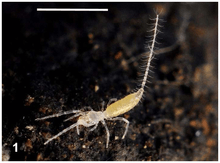Palpigradi
Palpigrades, commonly known as microwhip scorpions, are arachnids belonging to the order Palpigradi.
| Palpigradi | |
|---|---|
 | |
| Eukoenenia spelaea | |
| Scientific classification | |
| Kingdom: | |
| Phylum: | |
| Class: | |
| Order: | Palpigradi Thorell, 1900 |
| Families & genera | |
| |
Description
Palpigrades belong to the arachnid class.[2] They are the sister group to Thelyphonida, or whip scorpions,[3] no more than 3 millimetres (0.12 in) in length,[2] and averaging 1–1.5 mm (0.04–0.06 in).[3] They have a thin, pale, segmented integument, and a segmented abdomen that terminates in a whip-like flagellum. This is made up of 15 segment-like parts, or "articles", and may make up as much as half the animal's length.[4] Each article of the flagellum bears bristles, giving the whole flagellum the appearance of a bottle brush.[4] The carapace is divided into two plates between the third and fourth leg pair of legs. They have no eyes.
As in some other arachnids, the first pair of legs is modified to serve as sensory organs, and are held clear of the ground while walking. Unusually, however, palpigrades use their pedipalps for locomotion, so that the animal appears to be walking on five pairs of legs.[4]
Some palpigrades have three pairs of abdominal lung-sacs, although these are not true book lungs as there is no trace of the characteristic leaflike lamellae which defines book lungs. However, many species have no respiratory organs at all and breathe directly through the cuticle.[5]
Their exoskeleton is very weakly sclerotized compared to other arachnids, which is the reason why fossils are so rare, and go no further back than 99 million years ago in Burmese Amber.[6]
Ecology and behavior
Species of Palpigradi live interstitially in wet tropical and subtropical soils.[3] A few species have been found in shallow coral sands and on tropical beaches.[7] In Europe, they have been found in caves and underground spaces.[8] There is one endemic species on the island of Malta, in the Mediterranean Sea, which exists only in one specific cave.[2] They need a damp environment to survive, and they always hide from light, so they are commonly found in the moist earth under buried stones and rocks. They can be found on every continent, except in Arctic and Antarctic regions. Terrestrial Palpigradi have hydrophobic cuticles, but littoral (beach-dwelling) species are able to pass through the water surface easily.[7]
Very little is known about palpigrade behavior.[4] They are generally believed to be predators like their larger relatives, feeding on minuscule animals in their habitat.[4] However, their chelicerae have been described as "more like a comb or brush than the forceps of a predator", and the species Eukoenenia spelaea has been shown to feed on cyanobacteria ("blue-green algae").[8] Their mating habits are unknown, except that they lay only a few relatively large eggs at a time.[4]
Classification
By 2003, approximately 79 species of palpigrades had been described worldwide, in two families, containing a total of 7 genera.[9] The two families are differentiated by the presence of ventral sacs on sternites IV–VI in Prokoeneniidae, and their absence in Eukoeneniidae.[10]
Two fossil palpigrade species have been described. The first one is from the Onyx Marble of Arizona, which is probably of Pliocene age.[11] Its familial position is uncertain. The second one (Electrokoenenia yaksha), belonging to the family Eukoeneniidae, is known from Cretaceous (Cenomanian) amber from northern Myanmar.[1] Older publications refer to a fossil palpigrade (or palpigrade-like animal) from the Jurassic of the Solnhofen limestone in Germany,[12] but this has now been shown to be a misidentified fossil insect.[13]
See also
References
- Michael S. Engel; Laura C. V. Breitkreuz; Chenyang Cai; Mabel Alvarado; Dany Azar; Diying Huang (2016). "The first Mesozoic microwhip scorpion (Palpigradi): a new genus and species in mid-Cretaceous amber from Myanmar". The Science of Nature. 103 (3–4): 19. doi:10.1007/s00114-016-1345-4. PMID 26879963.
- Schembri, Patrick J.; Baldacchino, Alfred E. (2011). Ilma, Blat u Hajja: Is-Sisien tal-Ambjent Naturali Malti (in Maltese). p. 66. ISBN 978-99909-44-48-8.
- Peter Ax (2000). "Palpigradi – Holotracheata". Multicellular animals. The phylogenetic system of the Metazoa. Volume II. Springer. pp. 120–121. ISBN 978-3-540-67406-1.
- James B. Nardi (2007). Life in the soil: a guide for naturalists and gardeners. Chicago Lectures in Mathematics Series. University of Chicago Press. ISBN 978-0-226-56852-2.
- Barnes, Robert D. (1982). Invertebrate Zoology. Philadelphia, PA: Saunders College. p. 614. ISBN 0-03-056747-5.
- When the Invasion of Land Failed: The Legacy of the Devonian Extinctions
- Olav Geire (2009). "Palpigradi (Arachnidae)". Meiobenthology: the microscopic motile fauna of aquatic sediments. Springer. pp. 205–206. ISBN 978-3-540-68657-6.
- Smrž, Jaroslav; Kováč, Ľubomír; Mikeš, Jaromír & Lukešová, Alena (2013). "Microwhip Scorpions (Palpigradi) Feed on Heterotrophic Cyanobacteria in Slovak Caves – A Curiosity among Arachnida". PLoS ONE. 8 (10): e75989. doi:10.1371/journal.pone.0075989. PMC 3797709. PMID 24146804.
- Mark S. Harvey (2003). "Order Palpigradi Thorell". Catalogue of the smaller arachnid orders of the world: Amblypygi, Uropygi, Schizomida, Palpigradi, Ricinulei and Solifugae. CSIRO Publishing. pp. 151–174. ISBN 978-0-643-06805-6.
- Joel Cracraft & Michael J. Donoghue (2004). "Palpigrades (Palpigradi)". Assembling the tree of life. Oxford University Press. pp. 302. ISBN 978-0-19-517234-8.
- J. Mark Rowland & W. David Sissom (1980). "Report on a fossil palpigrade from the Tertiary of Arizona, and a review of the morphology and systematics of the order (Arachnida: Palpigradida)". Journal of Arachnology. 8: 69–86. JSTOR 3705206.
- Haase, E (1890). "Beitrag zur Kenntniss der fossilen Arachniden". Zeitschrift der Deutsche geologische Gesellschaft. 1890: 629–657.
- Xavier Delclòs; André Nel; Dany Azar; Günter Bechly; Jason A. Dunlop; Michael S. Engel; Sam W. Heads (2008). "The enigmatic Mesozoic insect taxon Chresmodidae (Polyneoptera): New palaeobiological and phylogenetic data, with the description of a new species from the Lower Cretaceous of Brazil" (PDF). Neues Jahrbuch für Geologie und Paläontologie, Abhandlungen. 247: 353–381. doi:10.1127/0077-7749/2008/0247-0353.
| Wikispecies has information related to Palpigradi |